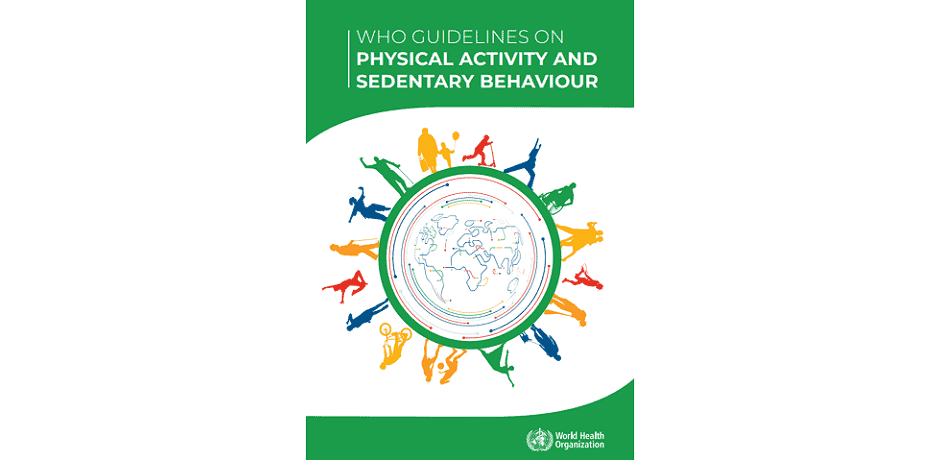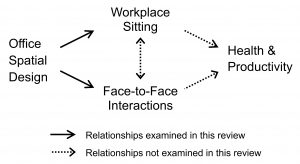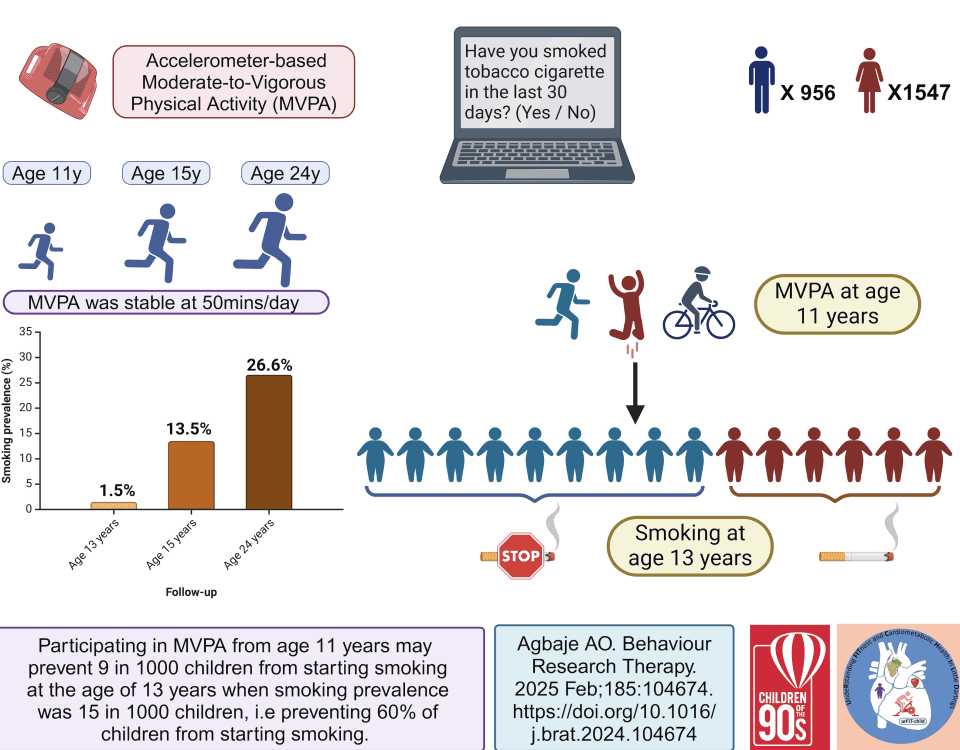
Longitudinal associations of sedentary time and physical activity duration and patterns with cognitive development in early childhood
November 13, 2020
2020 WHO guidelines on physical activity and sedentary behaviour just released!
November 26, 2020Today’s post comes from Dr Nyssa Hadgraft, a postdoctoral research fellow at the Centre for Urban Transitions at Swinburne University of Technology (Melbourne, Australia), describing their recent review “Office spatial design attributes, sitting, and face-to-face interactions: Systematic review and research agenda“ in Building and Environment. The full article can be found here.
How do office spatial environments influence sitting time and face-to-face interactions?
Many people now work in office-based jobs, which can be highly sedentary (1). As high levels of sitting time are associated with increased mortality and chronic disease risk (2), there has been increasing interest in effective strategies to reduce sitting in workplaces (3).
The spatial design of office environments may potentially influence sitting and other workplace behaviours. For example, people may sit more if they do not have other places to visit within the workplace, such as discussion spaces and meeting rooms. Office spatial design may also influence the frequency of informal face-to-face interactions with work colleagues by providing suitable places for conversations. Face-to-face interactions are considered important for improving the performance of knowledge-based workplaces (4).
Given that workplace sedentary behaviour and face-to-face interactions may be associated with workplace health and productivity outcomes, identifying modifiable office spatial factors that can influence these behaviours can inform better office design. We conducted a systematic review to synthesise the evidence on links between office spatial design factors with workplace sitting and informal face-to-face interactions.
What did we do?
We searched six databases in November 2019 (before the COVID-19 pandemic began) for peer-reviewed articles that examined associations of office spatial design attributes with sitting or face-to-face interactions. We excluded studies where multiple design features were combined (e.g. activity-based working) as we were interested in the associations with specific office spatial design attributes. Design attributes examined included office type (e.g. closed or open office), availability of shared spaces (e.g. kitchens, meeting rooms), spatial layout (e.g. how connected workspaces are to other spaces), proximity and visibility of co-workers.

What did we find?
Twenty articles were included in the systematic review, of which nine examined workplace sitting, 10 examined face-to-face interactions and one study examined both outcomes. The majority (17/20) were cross-sectional, with sample sizes ranging from 26 to over 5,000. The studies were conducted in the USA (n=10), Europe (n=5) and Australia (n=5).
There was some evidence that workers in open-plan offices had shorter bouts of sitting and overall sitting than those in closed offices, while better visibility of co-workers appeared to be associated with shorter bouts of sitting (but not overall sitting time). Having co-workers in closer proximity appeared to be associated with more frequent and longer face-to-face interactions, while open plan offices may be associated with more frequent, but shorter, face-to-face interactions.
Research gaps
Our review highlighted some opportunities for further research to improve understanding of links between office spatial design and workplace behaviours. These include:
- Assess the effects of office renovations or relocations on sitting and face-to-face interactions.
- Identify where workers sit, stand, and interact within the workplace to understand attributes of spaces where standing and interactions take place
- Conduct studies in a broader range of countries (e.g. non-Western countries), where organisational cultural norms may differ.
- Identify ways to minimise some of the detrimental effects of open plan office designs (such as increased noise levels), given they appear to have some benefits for reducing sitting and increasing interactions.
- Promote collaboration between the relevant sectors (e.g. design, management, and occupational health), which investigate this topic independently
So what?
We identified some aspects of office spatial design, such as open-plan offices and closer proximity and visibility of co-workers, that may be beneficial for reducing workplace sitting time and increasing co-worker interactions. However, given the mixed findings, additional research is needed to identify the most optimal—and easily modifiable—office design features to encourage workers to sit less and interact more frequently with colleagues. New research also needs to address physical distancing between workers so that they can work in a safe manner in the post COVID-19 era.
Citation
Sugiyama, T., Hadgraft, N., Clark, B.K., Dunstan, D.W., Chevez, A., Healy, G.N., Cerin, E., LaMontagne, A.D., Shibata, A., Oka, K., & Owen, N. (2021). Office spatial design attributes, sitting, and face-to-face interactions: Systematic review and research agenda. Building & Environment. 187, 107426. doi.org/10.1016/j.buildenv.2020.107426
About the authors
Professor Takemi Sugiyama is the leader of Healthy Cities research group in the Centre for Urban Transitions at Swinburne University of Technology (Melbourne, Australia). He explores how urban form (building, neighbourhood environments) can be modified to encourage active living and enhance population health.
Dr Nyssa Hadgraft is a postdoctoral research fellow at the Centre for Urban Transitions at Swinburne University of Technology. Her research interests include understanding the multi-level influences on physical activity and sedentary behaviour and their role as risk factors for chronic disease.
Professor Neville Owen is a National Health & Medical Research Council Senior Principal Research Fellow, Head of the Behavioural Epidemiology Laboratory at the Baker Heart & Diabetes Institute, and Distinguished Professor in Health Sciences at Swinburne University of Technology in Melbourne, Australia. His research links urban-environment attributes with physical inactivity, too much sitting, and risk of developing diabetes and heart disease.
REFERENCES
- Hadgraft NT, Healy GN, Owen N, Winkler EA, Lynch BM, Sethi P, et al. Office workers’ objectively assessed total and prolonged sitting time: Individual-level correlates and worksite variations. Prev Med Rep. 2016;4:184-91.
- Katzmarzyk PT, Powell KE, Jakicic JM, Troiano RP, Piercy K, Tennant B, et al. Sedentary behavior and health: Update from the 2018 Physical Activity Guidelines Advisory Committee. Med Sci Sports Exerc. 2019;51(6):1227-41.
- Chu AH, Ng SH, Tan CS, Win AM, Koh D, Muller-Riemenschneider F. A systematic review and meta-analysis of workplace intervention strategies to reduce sedentary time in white-collar workers. Obes Rev. 2016;17(5):467-81.
- Gloor PA, Grippa F, Putzke J, Lassenius C, Fuehres H, Fischbach K, et al. Measuring social capital in creative teams through sociometric sensors. International Journal of Organisational Design and Engineering. 2012;2(4):380-401.




